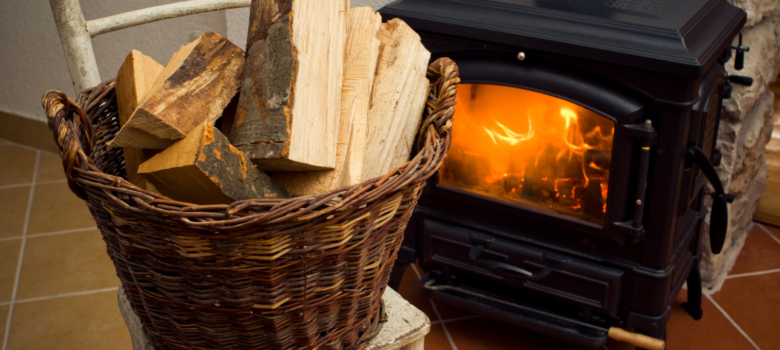
We’re living in a very different world than we were only 15 or 20 years ago. The general public has become a lot more aware of environmental concerns and carbon footprints, and we have seen an increase in trends associated with a sustainable and ecological way of life. Wood burning stoves have captured the interest of many homeowners; the combination of cheap heating and a cosy focal point within the property is an appealing idea. As a result, there are currently an estimated 1.5 million households in the UK with a wood burning stove, with around 200,000 more stoves being sold every year.
Many people believe a wood burning stove to be a significant step towards lowering their environmental impact, relying on a sustainable resource to heat their properties rather than purchasing energy from the central grid – much of which is generated by the burning of carbon-heavy fossil fuels. But how accurate is this idea? Are wood burners actually good for the environment?
Wood Burning Stoves: Carbon Neutral
Despite the fact that it gives off so much carbon dioxide, wood is a carbon-neutral energy source – it may seem counter-intuitive but in fact the logic is pretty simple. Through its life-cycle the tree will absorb a significant amount of carbon dioxide, and when the wood is burned the absorbed carbon is released back into the atmosphere. This amount of absorbed CO2 during the lifetime of the tree is balanced by the overall amount of CO2 released when the wood is burned. Therefore, the carbon dioxide actually added to the atmosphere is effectively zero.
In fact, based on this concept the government offers subsidies for some domestic wood burners. Though stoves are not included, wood-burning hot water boilers can qualify for the Renewable Heat Incentive (RHI), a scheme promoting sustainable power and providing quarterly cash repayments to cover the installation costs.
So if wood is carbon neutral then why are people banning them?
Wood Burning Stove Emissions
UK air quality has reached a crisis point, with towns and cities across the UK regularly failing to meet international standards. It’s a serious problem – the number of deaths attributed to outdoor pollution each year is in the tens of thousands. A joint study by Greenpeace and The Guardian last year revealed that nearly 50,000 children across England and Wales are exposed to dangerous levels of air pollution. The increased popularity of wood burners is making the problem worse – according to King’s College London, wood-burning in London accounts for up to 31% of the city’s particulate pollution – an increase of 10%.
This is particularly concerning to air quality specialists owing to the content of the emissions given off by burning wood. Specs of soot 100 times smaller than the diameter of a human hair are one of the most harmful kinds of air pollution, entering the body through the lungs and exacerbating heart and respiratory conditions. It’s called PM2.5 (doesn’t exactly roll off the tongue but what can you do) and it has the potential to be hugely dangerous.
The Clean Air Act, the Clean Air Strategy, and Smoke Control Areas
There have been several Clean Air Acts since it’s first instigation in 1956. Back then it was implemented in response to the Great Smog of London in 1952, in which coinciding weather conditions collected airborne pollutants arising from the use of coal to form a thick layer of smog over the city. According to medical reports, at least 4,000 people died as a direct result of the smog and 100,000 more were taken ill by the effect on the respiratory tract. I’m not just mentioning that to scare all my fellow Londoners and fill everyone with fear, I’m mentioning it to make the point that air pollution is a big problem and it’s happening now – not at some indeterminate point in the future, but now.
Among other things, the Clean Air Acts created smoke control areas across the UK. In these specified locations you cannot emit smoke from a chimney unless you’re burning an authorised fuel or using an ‘exempt appliance’. London Mayor Sadiq Khan has made the argument recently that this doesn’t go far enough, calling for an amendment to the current Clean Air Act. If Khan gets his way then wood-burning stoves would be banned completely for urban areas with poor air quality. The Department for Environment, Food & Rural Affairs (DEFRA) has also committed itself to the publication of a comprehensive Clean Air Strategy, which is to come into effect this year. The Clean Air Strategy will cover 5 major pollutants, one of which is fine particles – the PM2.5 we mentioned earlier. Watch this space – we’ll definitely want to go through that particular document when it comes out and report back to our readers.
It seems that whatever your opinion on the effect of wood burning on the environment, the trend of installing them in city centre residences and urban dwellings may well be coming to a close.
Think we missed something? Do you have a different opinion?
Comment below to get your voice heard…



















Great and informative post! However, I don’t really think that the trend of installing wood burning stoves is coming to a close. I would like to hear your opinion on wood burners with clean burn technology as they seem to be gaining popularity in the market. Also, they’re known to produce fewer soot particles which makes them an eco-friendly choice. I actually have this kind of stove at home which I got from this wood burning stoves York based seller. It’s DEFRA approved too, so I think I’m able to keep the ambient temperature at home without damaging the environment.
It’s impossible to burn wood without producing super fine particulate matter – which cannot be stopped by filters. This is a big problem in residential areas within the UK and across Europe. where lots of people have woodturning stoves and all fire them up on a cold evening – lowering the air quality significantly. And all around them are suffering as a result of this,
If my neighbours light their wood burner we literally choke if we go outside
Mynext door family have a wood burner the fumes and smell when they light upp is very bad we have to shut windos etc we are 4 metres away tha smoke etc drops down between the bungalows what can i do.
How about local policing of smoking chimneys and fines? Would this not work to reduce the pollution? Fines could raise moneys to go towards local green projects? I didn’t think a good dry clean firewood fuel should smoke at all?
Although a lot of the information in this piece is good, the claim that wood stoves are being banned is completely ridiculous, unfounded and just not true. Please be more careful when writing ‘informative’ articles.
I am not sure they are generally carbon neutral, unless you cut the wood with a handsaw from a local source. Most wood is cut by chainsaw , kiln dried and transported by van or lorry, all of which rely on fossil fuels.
No doubt in future there’ll be electric chainsaws, electric kilns and electric lorries. As trees rot they release their co 2 so as long as more trees are planted than are cut then wood burners would be carbon nuetral.
Still better than cutting down a forest, building a gas works, putting pipework all over the land and burning a fossil fuel
This carbon neutral myth just isn’t right. Wood takes years to grow and minutes to burn so the Growth and destruction of trees is fundamentally incomparable. The only green way to heat your house is with green electricity and that’s that. If you want to help the environment get electric heating and either generate the power yourself or seek a supplier that does so from renewables. Otherwise you’re just kidding yourself. Wood burners are lovely things but cutting down trees is now where we want to be.
I beg to differ, wood burning from coppiced woodland is carbon neutral and therefore a very sustainable source of energy. I own a piece of woodland that we coppice, when you coppice a tree, the stump that is left will grown around 5-7 new trees, so in fact its very sustainable if you do it like that. Most small local sawmills as well as large forestry authorities will do this as its not only environmentally sustainable but it means that you can work in different areas whilst the new trees regrow.
I agree , I suspect you live in a fairly rural area as I do . I do think about the future thats why I am looking at buying 2 electric bikes , my next new car will also be electric and also thinking about solar heating / PV when the UK government show us some Initiative with cost again . I am not saying burning anything in the middle of a city is a good thing however I think there is a time and a place using common sense in more sparsely populated areas . I do not kill living trees my self just for the sake of it . Polarding and coppicing is obviously different . If a neighbour or friend has had a tree taken down for safety reasons I help to remove it . If it is left insitu it will rot and give off more or less the same amount of CO2 as if it was burnt ( I accept it gives home for bugs and all that lives on them and give off some particulates ) . I only use a small amount of petrol to to reduce the tree to blocks then manually or electrically split them and season them for a year or two . Burning the correct wood with a low moisure content with enough oxygen in the wood burner will produce some smoke but not a huge ammount . My wood burner does not interfere with any one else as I only use it November to March on cold evenings when evey house holder has their doors closed anyway and the particulates diluted in the 4 cardinal winds . We are “lucky ” ( for now ) we have a gas boiler outside these times which is obviously fossil fuel … which is best for the planet ? I will only give up my wood burner when all fossil fuel power stations are replaced by nuclear / hydro/ tide but can’t see wind turbines and solar on windless nights themselves cope with the demand of street lights , heating every home and charging every electric vehicle over night.. but it all helps . Lorries , cars, ships and aircraft flights have to be hydrogen / electric powered and the annual bon fire night is cancelled and all countries show commitment to a cleaner world . I’m all for a cleaner planet but I hope all the people who want to rid the world of wood burners think of what they could do themselves … no transport ( foot or pedal cycle only ) until fossil fuel power stations cease ,meaning every one has to be self sufficient and work from home with no holidays away from home . More allotments with fresh seasonal veg with pigs bees and chickens !! The waste of energy one sees .. office blocks lit up 24/7 , non essential street lights , advertising lights , cars with only 1 person in them going to work ( the lock down proves the country can manage ) the list is endless … scrap hs2 and spend the money on subsidised public transport with a meaningful timetable …. there is the place to start not the poor wood burner . When I see all the worlds leaders show their results I will follow in ernest and scrap my wood burner .
I agree with you totally. I would love a wood burning stove. I’m not allowed one as I live in an old granite council property unsuitable for insulation in a village in Scotland.Really cold in winter. Had a power cut last night and no heating. With energy prices escalating it’s going to be hard to keep warm in winter. Have my own garden with trees.Dry the wood and give it away.I walk everywhere. Don’t own a car and think about the environment. It’s not fair. Compared to many, my carbon footprint is zilch.
Well said. I would like to see all the public buildings in large cities do away with their flood lighting. Why is it needed. Also massive skyscraper office blocks illuminated all night, why? I know cleaning has to go on and there are also night workers but not in every place and building.
I have just got an electric car. I do all I can to reduce my waste and reduce my carbon footprint.
Let those at the top lead by example. COP 26 is just the tip of the iceberg. And lots of blah blah as Greta says.
I even save seeds from my vegetable to sow next year. There is only so much individual households can do. If I can replace my gas fire with a log burner I will do so when I can afford it I’m 75. Also served as a nurse for 40 years in the NHS.
how can you possibly believe its sustainable, it takes years for a tree to grow and a few hours to burn it
But why does that make it unsustainable?
I agree. Wood is a RENEWABLE source of energy. Gas and coal are fossil fuels. Burning wood is carbon neutral, unlike gas and coal. My gas central heating is only switched on for an hour a day in the winter and not at all, on some days, even in the depths of winter. Wood burners are more efficient than an open fire. Perhaps the amount of cars on the road, especially used for short journeys, flights taken in a year, should be addressed before targeting households with stoves. The Clean Air Act that prohibited fires in cities, seems to have be ignored in recent years. Perhaps this should be readdressed.
When an aircraft goes over I dont feel the need to hide indoors, as I do when everyone lights their poisonous wood stoves
I recall that prior to installing my log burner several years ago I had to contact my local council and had to agree to burn clean, untreated wood, preferably kiln dried only and had I not agreed to this then my proposed installation would have been banned. As a result I don’t even burn offcuts of wood purchased from my local DIY supplier, e.g. fencing posts.Cleaning out the deposits from the base of my chimney each year there appears to very little “soot” just a handful of fine granular particles. I tend to switch off my gas central heating when I light the log burner, which is installed in my lounge. I think that this is more eco-friendly, however, I take the point that kiln drying wood and transporting it to retailers, etc. uses energy. What is the individual to do to help the environment ? Not an easy one to answer !
BBC radio Bristol this morning gave a really good broadcast this morning on the problems of stoves. Lots of exaggeration as the London study figures included over 70% of open fires. It seems particulate issues for correctly operated wood burners are close to zero but not if the stove is old or incorrectly fuelled.
If wood is burned in a high quality wood stove, the net result is positive. The problem of air pollution, which can be controlled by using a good quality burner, is one of perspective. Air pollution is a relatively short term issue whereas global warming is a long term issue. We can do things to mitigate air pollution which is a relatively short term issue whereas global warming is a long term issue. We can do things to mitigate air pollution, but in the long term, burning wood, if done responsibly, is far better than burning any fossil fuels.
Sorry complete rubbish, How people think that cutting down trees and burning them is environmental friendly shows our naive the herd can be. Barnum would have been proud.
your comment about wood burning being vitually c02 neutral doesnt add up if you cut a tree down to burn it then there is no tree to absorb the poison
So why not coppice? Or, failing that for some reason, plant a new tree? There were 13000 additional hectares of woodland in the UK in 2019-2020, so clearly not a net loss of trees going on despite burning.
I can’t wait for the end of wood burners altogether – and wood chip boilers. The fumes and smoke from these appliances is unhealthy and making the urban environment much much worse than it used to be. You can’t go outside these days without breathing in smoke. I have stopped recreatiional sport outside altogether now just because the smoke is so bad where I live, Wood burners are not green.
I’m in York, stoves very popular on my estate, AQI was 176 in my garden at 12.30! No visible smoke, council can do nothing unless smoke for 15 minutes.
Mynext door family have a wood burner the fumes and smell when they light upp is very bad we have to shut windos etc we are 4 metres away tha smoke etc drops down between the bungalows what can i do.
I think log burners should be banned unless the property is off the grid.
We live in a road of small bungalows and our neighbour had a log burner fitted 2 years ago, the smoke pours down into the garden and we have to close windows and going outside just to empty the kitchen bin you come back in stinking of smoke. We have complained numerous times and he insists he is burning smokeless fuel, however the the brown stains around the top of the pipe would say otherwise, I would welcome a ban ( unless of the grid) have some sort to taxation for people that already have them…..just don’t get me started on bonfires either!!
The bottom line is that wood burners spoil the quality of air around them. Like soo many others, my neighbour had one installed and my area has went from clean fresh air to smoke. This is the problem! People who own wood burners are the most selfish there is.
I’d like to better understand how the environmental impact of wood-burning compares to other forms of home-heating, particularly as there is a growing emphasis on electrifying home-heating. Can anyone point me in the direction of useful comparative analysis or statistics? Thanks.
Your question is so sensible. The issue for so many decisions is accurate, substantiated, clear and understandable information. The range of options and counter argument demonstrates this. Brexit, environment, Covid all show this. Who can we trust?